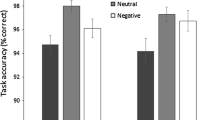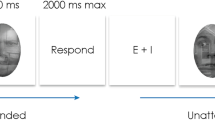Abstract
Although research has shown that emotional content modulates attention, such studies often differ in the types of stimuli used to evoke emotions. Some studies utilize emotionally valenced scenes and others utilize emotional facial expressions. Importantly, the comparability of the effect of these two stimulus classes on attention is unclear. In the present experiments, we contrasted the effects of emotional scenes and facial expressions with the same valence on visual search speed. Overall, scenes caused greater disruption in visual search than faces, and emotional content appeared to modulate this effect with larger differences between scenes and faces arising for more negatively valenced stimuli. This pattern of findings was largely replicated after varying task difficulty in Study 2 and the visual properties of the search array and task difficulty in Study 3. These findings indicate that emotional scenes and faces produce differential effects on attention, and suggest that negative emotional scenes are particularly potent in disrupting the allocation of attention.






Similar content being viewed by others
Notes
These scenes were roughly matched for brightness and clarity. An independent sample of healthy controls (n = 20) rated each Anger (M = 51.71, SD = 27.96), Disgust (M = 42.50, SD = 23.34), Fear (M = 48.73, SD = 24.18), Happy (M = 39.53, SD = 20.69) and Neutral (M = 2.62, SD = 3.73) scene on arousal (0 = none to 100 = extremely/most imaginable). Emotional scenes (anger, fear, disgust, and happy) were found to be statistically higher on arousal when compared to neutral scenes (p’s < .05). Furthermore, the emotional scenes (anger, fear, disgust, and happy) did not statistically differ from each other on arousal (p’s > .05). Participants also completed a forced-choice task that required them to place each scene in one of five emotional categories: anger, fear, disgust, happy or neutral. Scenes where assigned to their predetermined emotional category the majority of the time: anger (65 %), fear (72 %), disgust (91 %), happy (93 %) or neutral (96 %). However, participants were more likely to mislabel anger scenes than other scenes.
Scenes were presented for only 500 ms before the visual search task because time (100, 500 ms) was not found to significantly interact with stimulus (scene, face) or emotion (anger, disgust, fear, happy, neutral) in Study 1.
References
Alpers, G. W., Adolph, D., & Pauli, P. (2011). Emotional scenes and facial expressions elicit different psychophysiological responses. International Journal of Psychophysiology, 80, 173–181.
Andrews, T. J. (2005). Visual cortex: How are faces and objects represented? Current Biology, 15, R451–R453.
Armony, J. L., Servan-Schreiber, D., Cohen, J. D., & LeDoux, J. E. (1997). Computational modeling of emotion: Explorations through the anatomy and physiology of fear conditioning. Trends in Cognitive Sciences, 1, 28–34.
Arnell, K. M., Killman, K. V., & Fijavz, D. (2007). Blinded by emotion: Target misses follow attention capture by arousing distractors in RSVP. Emotion, 7, 465–477.
Awe, E., Serences, J., Laurey, P., Dhaliwal, H., van der Jagt, T., & Dassonville, P. (2004). Evidence against a central bottleneck during the attentional blink. Multiple channels for configural and feature processing. Cognitive Psychology, 48, 95–126.
Bar, M., & Neta, M. (2007). Visual elements of subjective preference modulate amygdale activation. Neuropsychologia, 45, 2191–2200.
Becker, M. W. (2009). Panic search: Fear produces efficient visual search for nonthreatening objects. Psychological Science, 20, 435–437.
Berggren, N., Richards, A., Taylor, J., & Derakshan, N. (2013). Affective attention under cognitive load: Reduced emotional biases but emergent anxiety-related costs to inhibitory control. Frontiers in Human Neuroscience, 7, 188.
Bradley, M. M., Codispoti, M., Cuthbert, B. N., & Lang, P. J. (2001). Emotion and motivation I: Defensive and appetitive reactions in picture processing. Emotion, 1, 276–298.
Bradley, M. M., Moulder, B., & Lang, P. J. (2005). When good things go bad: The reflex physiology of defense. Psychological Science, 16, 468–473.
Britton, J. C., Taylor, S. F., Sudheimer, K. D., & Liberzon, I. (2006). Facial expressions and complex IAPS pictures: Common and differential networks. Neuroscene, 31, 906–919.
Ciesielski, B. G., Armstrong, T., Zald, D. H., & Olatunji, B. O. (2010). Emotion modulation of visual attention: Categorical and temporal characteristics. PLoS One, 11(5), e13860.
Cisler, J. M., & Koster, E. H. W. (2010). Mechanisms of attentional biases towards threat in anxiety disorders: An integrative review. Clinical Psychology Review, 30, 203–216.
Corbetta, M., & Shulman, G. L. (2002). Controls of goal-directed and stimulus-driven attention in the brain. Nature Neuroscience, 3, 201–215.
Eastwood, J. D., Smilek, D., & Merikle, P. M. (2001). Differential attentional guidance by unattended faces expressing positive and negative emotion. Perception and Psychophysics, 63, 1004–1013.
Eimer, M., Kiss, M., & Cheung, T. (2010). Priming of pop-out modulates attentional target selection in visual search: Behavioural and electrophysiological evidence. Vision Research, 50, 1353–1361.
Finkbeiner, M., & Palermo, R. (2009). The role of spatial attention in nonconscious processing: A comparison of face and nonface stimuli. Psychological Science, 20, 42–51.
Fox, E., Russo, R., & Dutton, K. (2002). Attentional bias for threat: Evidence for delayed disengagement from emotional faces. Cognition and Emotion, 16, 355–379.
Hajcak, G., & Olvet, D. M. (2008). The persistence of attention to emotion: Brain potentials during and after picture presentation. Emotion, 8, 250–255.
Hariri, A. R., Tessitore, A., Mattay, V. S., Fera, F., & Weinberger, D. R. (2002). The amygdala response to emotional stimuli: A comparison of faces and scenes. Neuroscene, 17, 317–323.
Hodsoll, S., Viding, E., & Lavie, N. (2011). Attentional capture by irrelevant emotional singleton faces. Emotion, 11, 346–353.
Kanwisher, N., McDermott, J., & Chun, M. M. (1997). The fusiform face area: A module in the human extrastriate cortex specialized for face perception. Journal of Neuroscience, 17, 4302–4311.
Keil, A., & Ihssen, N. (2004). Identification facilitation for emotionally arousing verbs during the attentional blink. Emotion, 4, 23–35.
Koster, E. H. W., Crombez, G., Verschuere, B., Vanvolsem, P., & De Houwer, J. (2007). A time-course analysis of attentional cueing by threatening scenes. Experimental Psychology, 54, 161–171.
Kristjánsson, Á., Óladóttir, B., & Most, S. B. (2013). “Hot” facilitation of “cool” processing: Emotional distraction can enhance priming of visual search. Journal of Experimental Psychology: Human Perception and Performance, 39, 298–306.
Krusemark, E. A., & Li, W. (2011). Do all threats work the same way? Divergent effects of fear and disgust on sensory perception and attention. Journal of Neuroscience, 31, 3429–3434.
Landau, N. A., & Bentin, S. (2008). Attentional and perceptual factors affecting the attentional blink for faces and objects. Journal of Experimental Psychology: Human Perception and Performance, 34, 818–830.
Lang, P., Bradley, M., & Cuthbert, B. (2005). International affective picture system (IAPS): Affective ratings of pictures and instruction manual (Technical Report A-6). Gainesville, FL: University of Florida.
Lundqvist, D., Bruce, N., & Öhman, A (2014). Finding an emotional face in a crowd: Emotional and perceptual stimulus factors influence visual search efficiency. Cognition and Emotion. doi:10.1080/02699931.2014.927352.
Lundqvist, D., Flykta, A., & Öhman, A. (1998). The Karolinska directed emotional faces—KDEF [CD-ROM]. Stockholm: Department of Clinical Neuroscience, Psychology section, Karolinska Institute.
McHugo, M., Olatunji, B. O., & Zald, D. H. (2013). The emotional attentional blink: What we know so far. Frontiers in Human Neuroscience. doi:10.3389/fnhum.2013.00151.
Milders, M., Sahraie, A., Logan, S., & Donnellon, N. (2006). Awareness of faces is modulated by their emotional meaning. Emotion, 6, 10–17.
Mogg, K., & Bradley, B. P. (1999). Orienting of attention to threatening facial expressions presented under conditions of restricted awareness. Cognition and Emotion, 13, 713–740.
Mogg, K., Bradley, B. P., Miles, F., & Dixon, R. (2004). Time course of attentional bias for threat scenes: Testing the vigilance-avoidance hypothesis. Cognition and Emotion, 18, 689–700.
Most, S., Smith, S., Cooter, A., Levy, B., & Zald, D. (2007). The naked truth: Positive, arousing distractors impair rapid target perception. Cognition and Emotion, 21, 964–981.
Müller, M. M., Andersen, S. K., & Attar, C. H. (2011). Attentional bias to briefly presented emotional distractors follows a slow time course in visual cortex. Journal of Neuroscience, 31, 15914–15918.
Nakayama, K., & Joseph, J. S. (1998). Attention, pattern recognition and popout in visual search. In R. Parasuraman (Ed.), The attentive brain (pp. 279–298). Cambridge, MA: MIT Press.
Notebaert, L., Crombez, G., Van Damme, S., De Houwer, J., & Theeuwes, J. (2010). Looking out for danger: An attentional bias towards spatially predictable threatening stimuli. Behaviour Research and Therapy, 48, 1150–1154.
Öhman, A., & Mineka, S. (2001). Fear, phobias and preparedness: Toward an evolved module of fear and fear learning. Psychological Review, 108, 483–522.
Olatunji, B. O., Ciesielski, B. G., Armstrong, T., & Zald, D. H. (2011). Emotional expressions and visual search efficiency: Specificity and effects of anxiety symptoms. Emotion, 11, 1073–1079.
Pessoa, L., & Adolphs, R. (2010). Emotion processing and the amygdala: From a “low road” to “many roads” of evaluating biological significance. Nature Reviews Neuroscience, 11, 773–783.
Phelps, E. A., & LeDoux, J. E. (2005). Contributions of the amygdala to emotion processing: From animal models to human behavior. Neuron, 48, 175–187.
Phelps, E. A., Ling, S., & Carrasco, M. (2006). Emotion facilitates perception and potentiates the perceptual benefits of attention. Psychological Science, 17, 292–299.
Puce, A., Allison, T., Gore, J. C., & McCarthy, G. (1995). Face sensitive areas in the human extrastriate cortex studied by functional MRI. Journal of Neurophysiology, 74, 1192–1199.
Roelofs, K., Hagenaars, M. A., & Stins, J. (2010). Facing freeze: Social threat induces bodily freeze in humans. Psychological Science, 21, 1575–1581.
Sabatinelli, D., Fortune, E. E., Li, Q., Siddiqui, A., Krafft, C., Oliver, W. T., et al. (2011). Emotional perception: Meta-analyses of face and natural scene processing. Neuroscene, 54, 2524–2533.
Santos, I. M., Iglesias, J., Olivares, E. I., & Young, A. W. (2008). Differential effects of object-based attention on evoked potentials to fearful and disgusted faces. Neuropsychologia, 46, 1468–1479.
Schafer, A., Schienle, A., & Vaitl, D. (2005). Stimulus type and design influence hemodynamic responses towards visual disgust and fear elicitors. International Journal of Psychophysiology, 57, 53–59.
Schimmack, U. (2005). Attentional interference effects of emotional pictures: Threat, negativity, or arousal? Emotion, 5, 55–66.
Schmidt-Daffy, M. (2011). Modeling autonomic threat detection: Development of a face-in-the-crowd task. Emotion, 1, 153–168.
Schubö, A., Gendolla, G. H. E., Meinecke, C., & Abele, A. E. (2006). Detecting emotional faces and features in a visual search paradigm: Are faces special? Emotion, 6, 246–256.
Smith, S. D., Most, S. B., Newsome, L. A., & Zald, D. H. (2006). An emotion-induced attentional blink elicited by aversively conditioned stimuli. Emotion, 6, 523–527.
Stein, T., Peelen, M. V., Funk, J., & Seidl, K. N. (2010). The fearful-face advantage is modulated by task demands: Evidence from the attentional blink. Emotion, 10, 136–140.
Susskind, J. M., Lee, D. H., Cusi, A., Feiman, R., Grabski, W., & Anderson, A. K. (2008). Expressing fear enhances sensory acquisition. Nature Neuroscience, 11, 843–850.
van Hooff, J. C., Devue, C., Vieweg, P. E., & Theeuwes, J. (2013). Disgust- and not fear-evoking image hold our attention. Acta Psychologica, 43, 1–6.
Vermeulen, N., Godefroid, J., & Mermillod, M. (2009). Emotional modulation of attention: Fear increases but disgust reduces the attentional blink. PLoS One, 4, e7924.
Vuilleumier, P. (2005). How brains beware: Neural mechanisms of emotional attention. Trends in Cognitive Sciences, 9, 585–594.
Weierich, M. R., Treat, T. A., & Hollingworth, A. (2008). Theories and measurement of visual attentional processing in anxiety. Cognition and Emotion, 22, 985–1018.
Whalen, P. J. (1998). Fear, vigilance, and ambiguity: Initial neuroimaging studies of the human amygdala. Current Directions in Psychological Science, 7, 177–188.
Yang, E., Zald, D. H., & Blake, R. (2007). Fearful expressions gain preferential access to awareness during continuous flash suppression. Emotion, 7, 882–886.
Zald, D. H. (2003). The human amygdala and the emotional evaluation of sensory stimuli. Brain Research Reviews, 41, 88–123.
Acknowledgments
The authors would like to thank David Zald for comments on earlier drafts of this manuscript.
Author information
Authors and Affiliations
Corresponding author
Rights and permissions
About this article
Cite this article
Olatunji, B.O., Armstrong, T. & Ciesielski, B.G. Differential effects of emotional expressions and scenes on visual search. Motiv Emot 39, 589–601 (2015). https://doi.org/10.1007/s11031-015-9477-y
Published:
Issue Date:
DOI: https://doi.org/10.1007/s11031-015-9477-y




